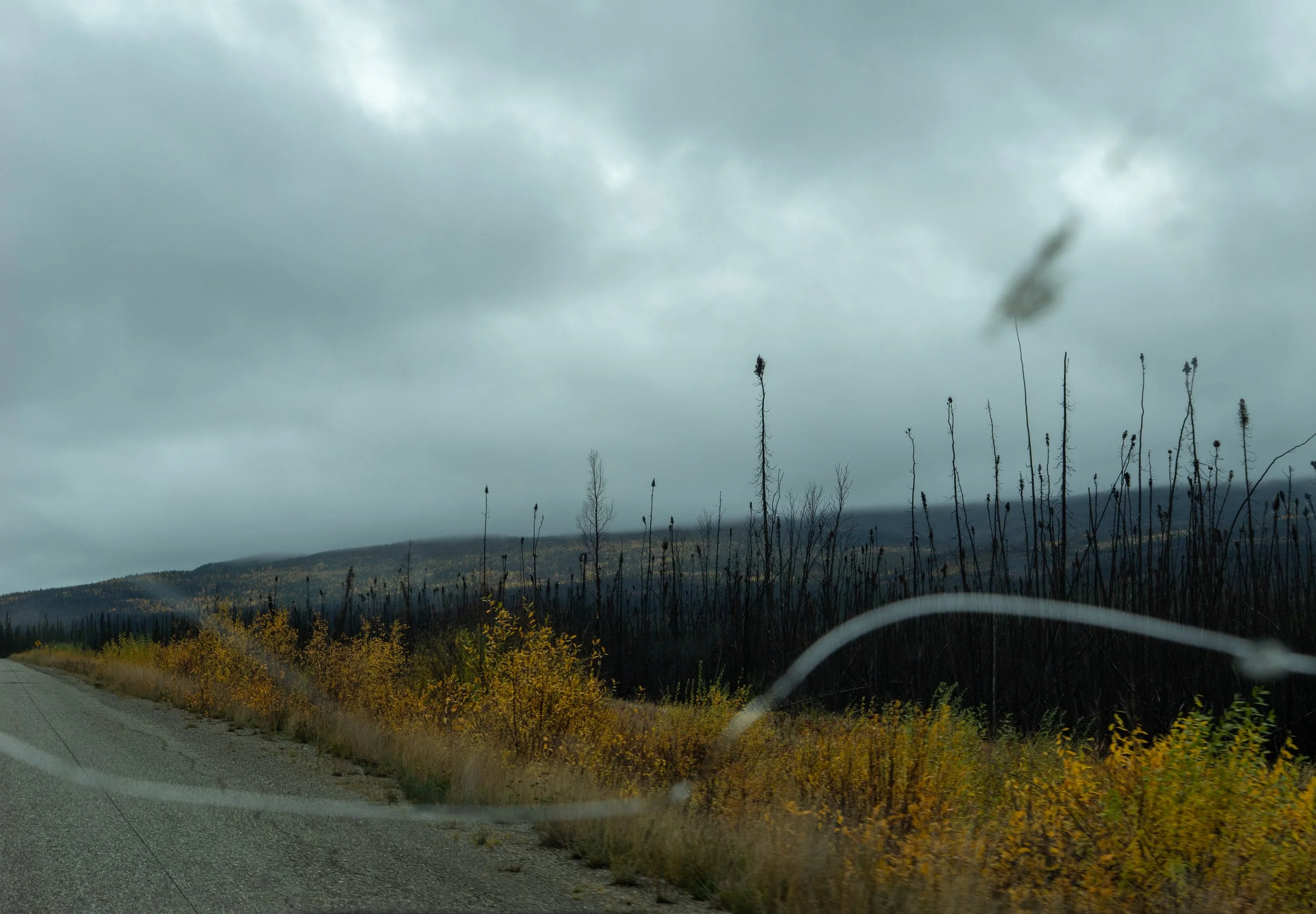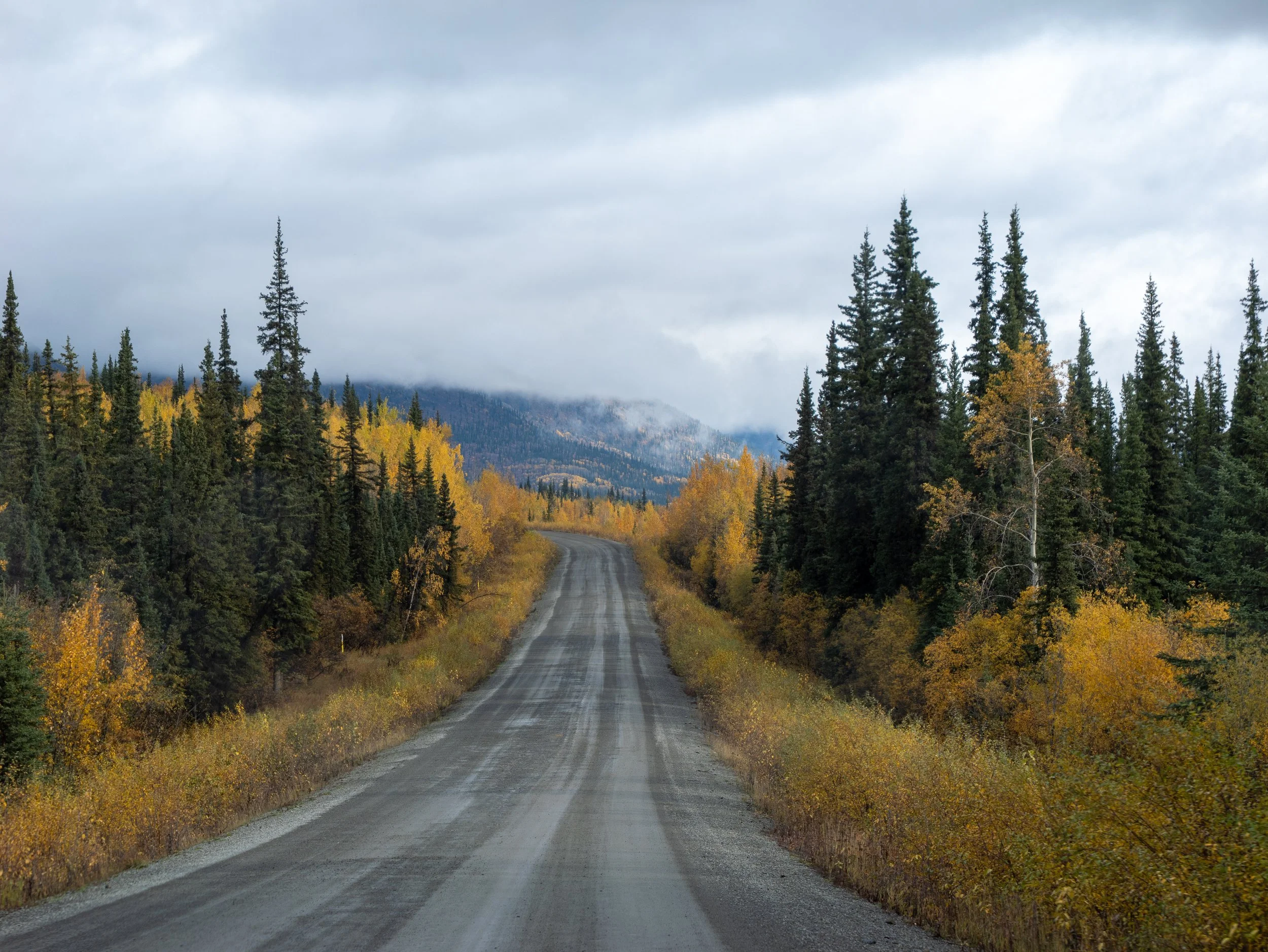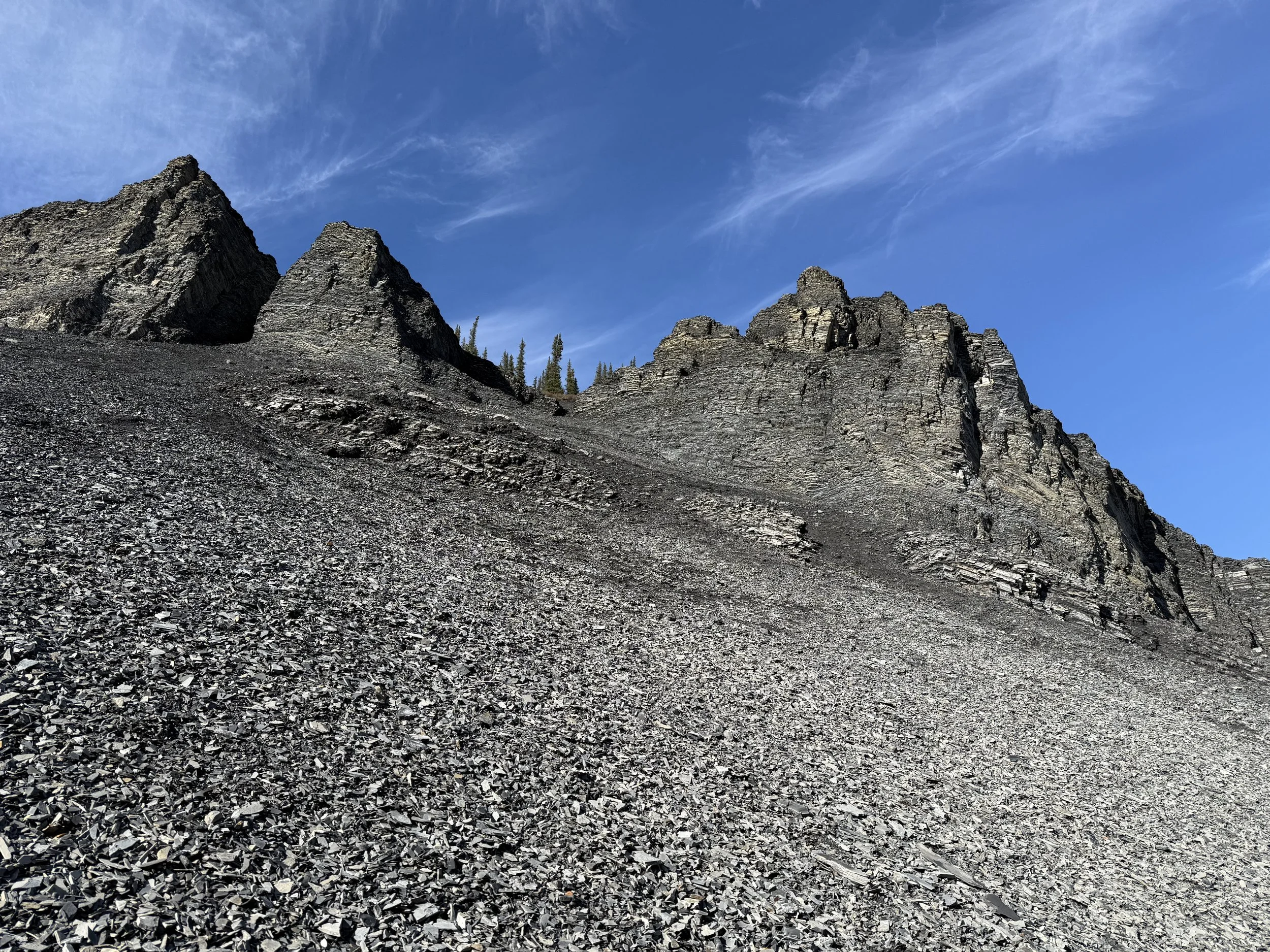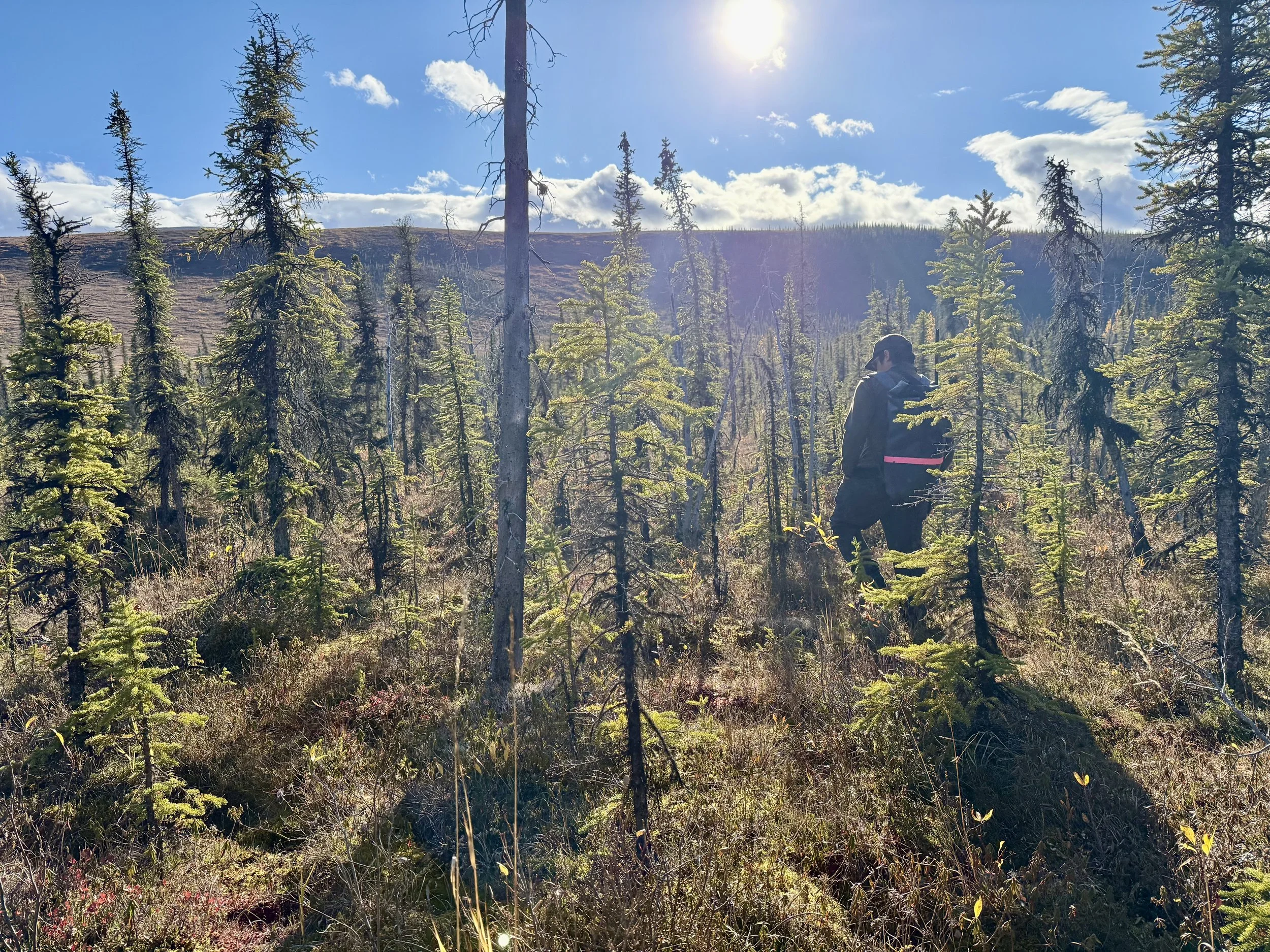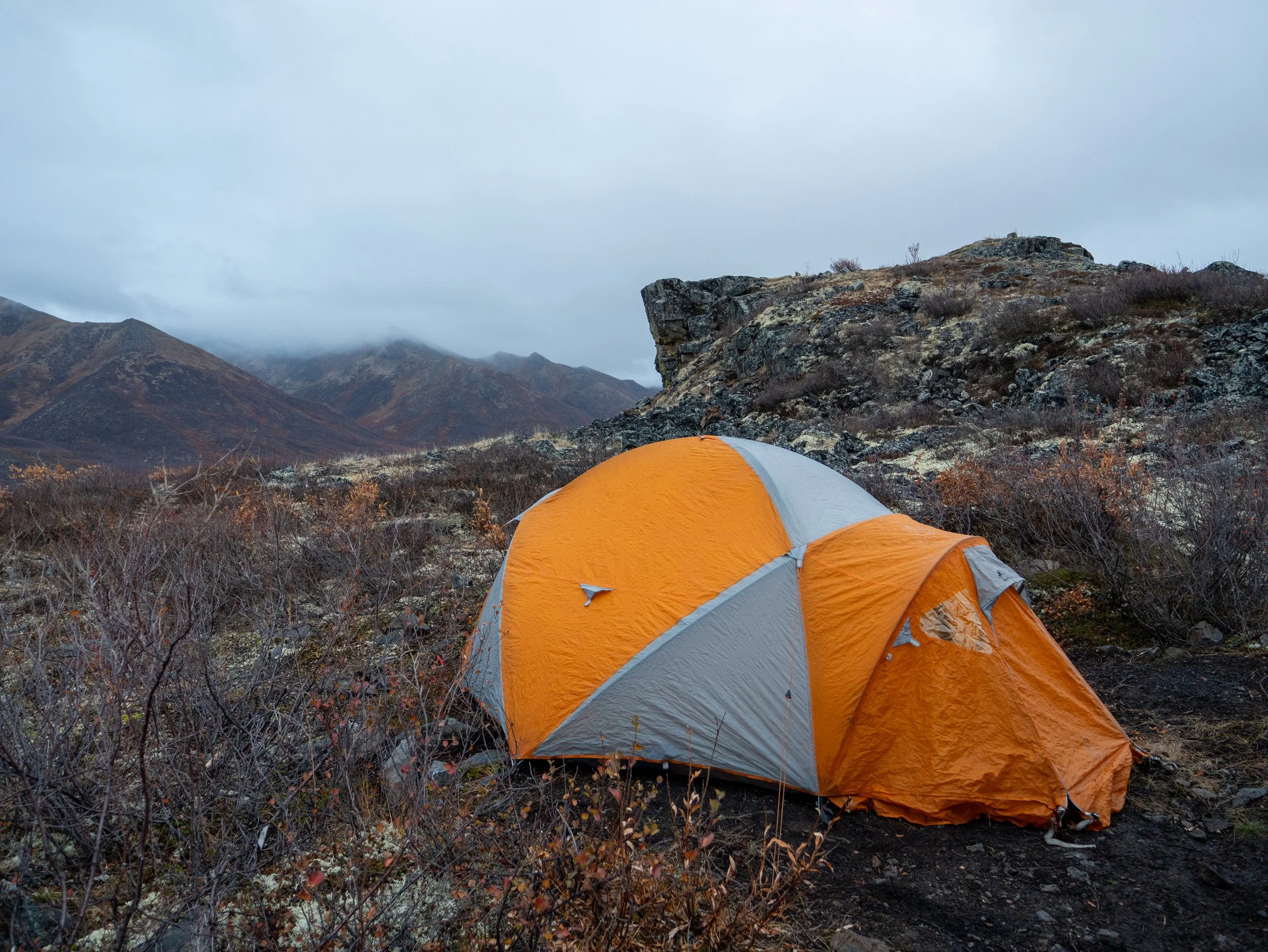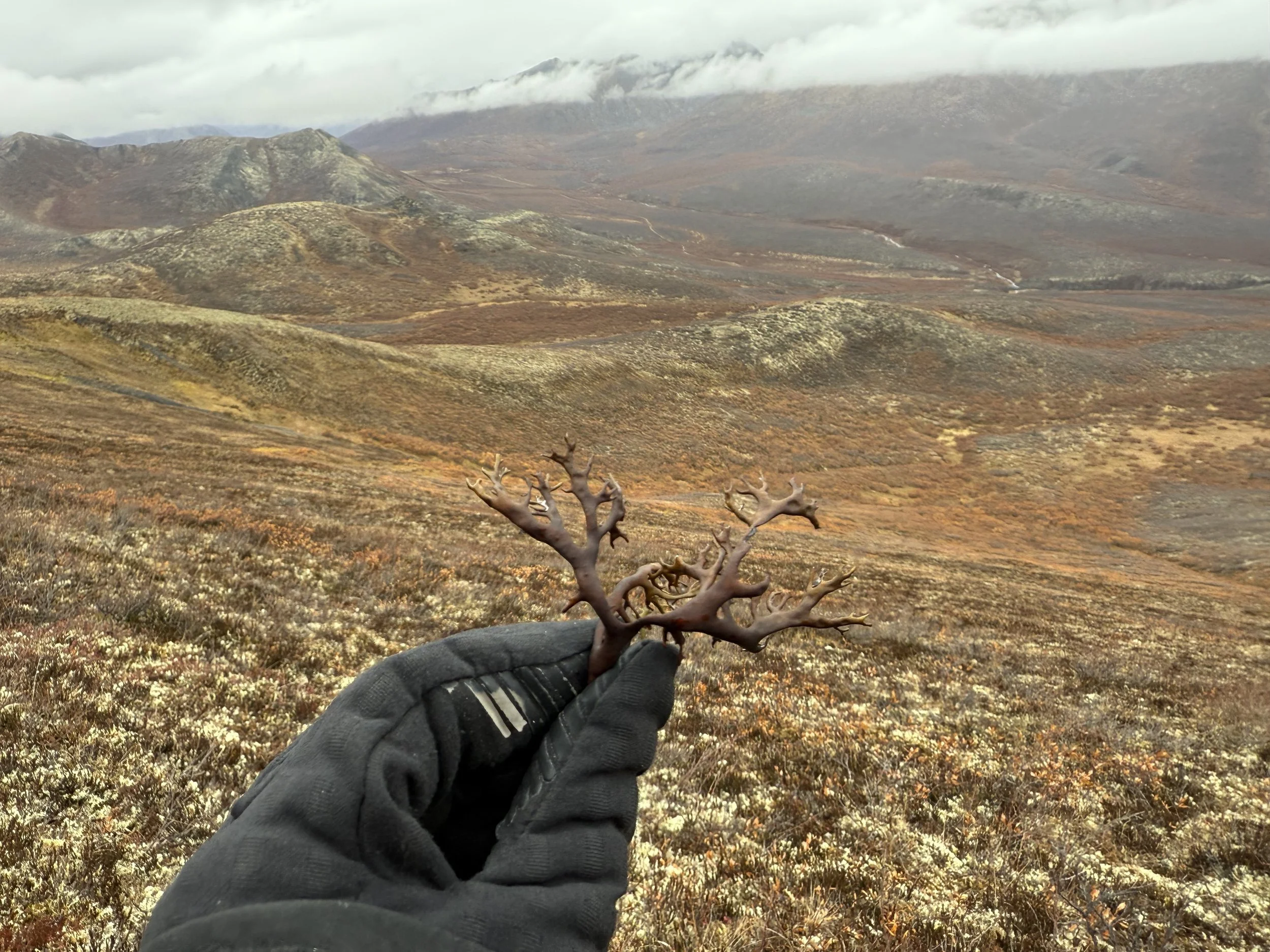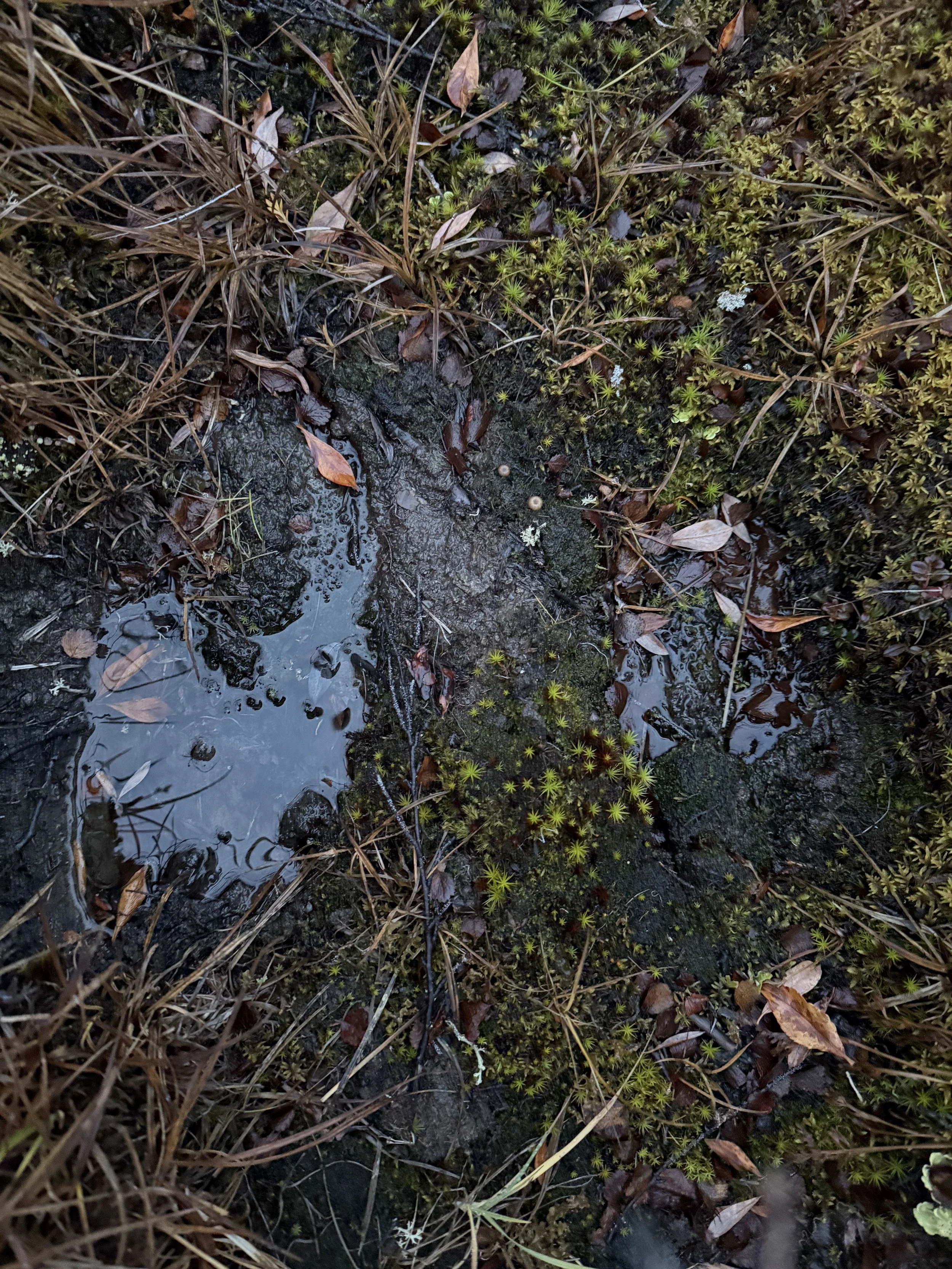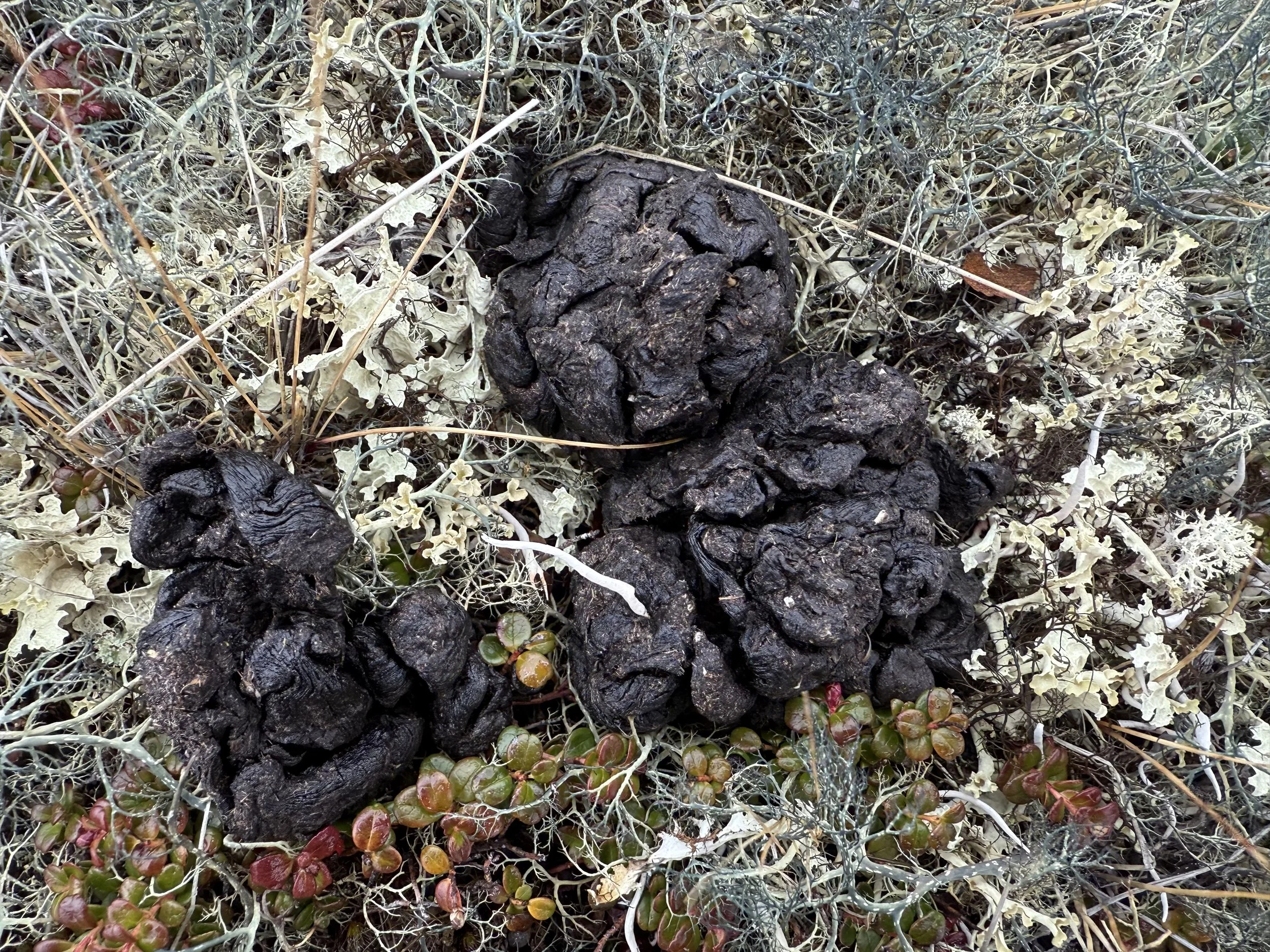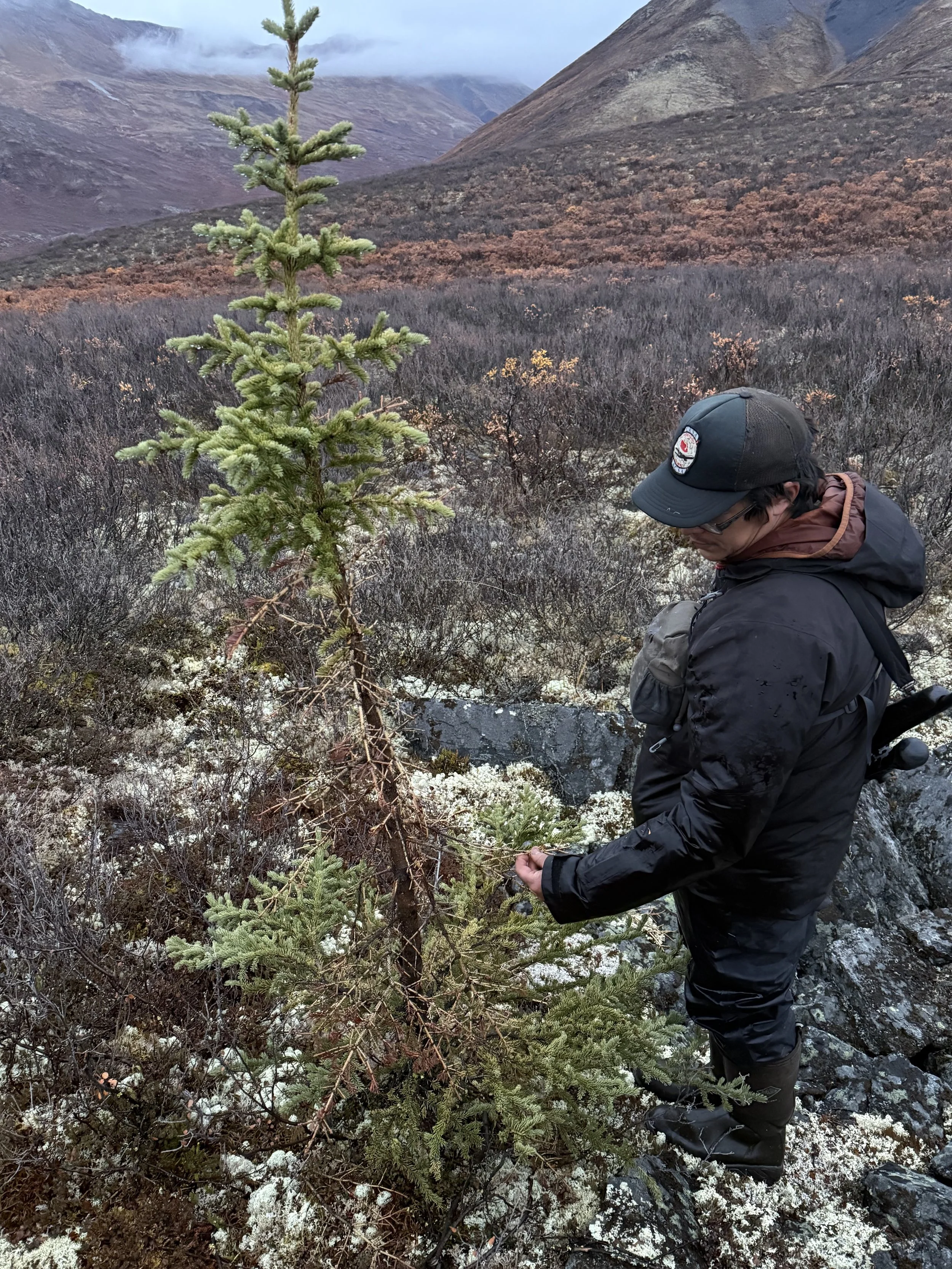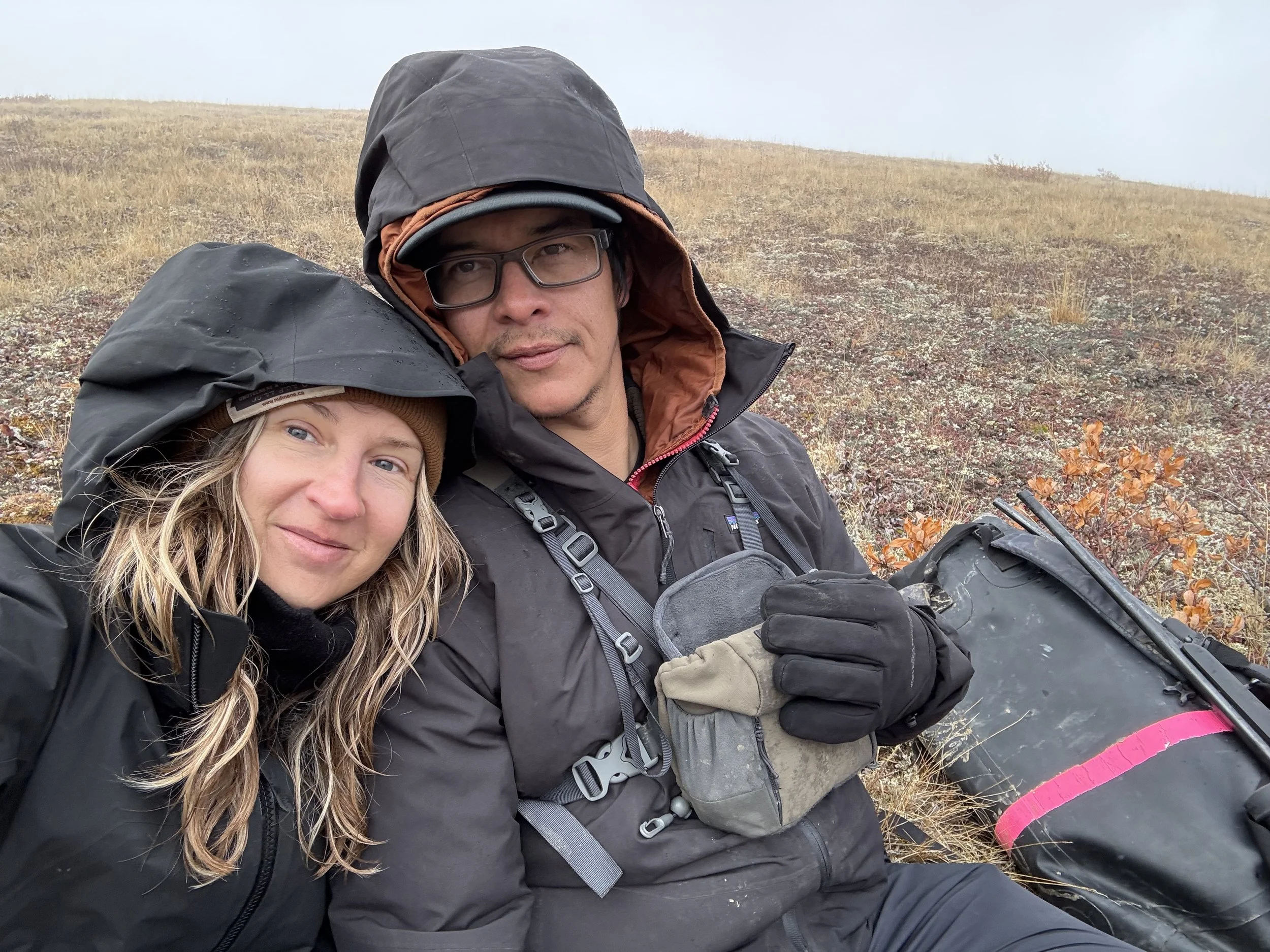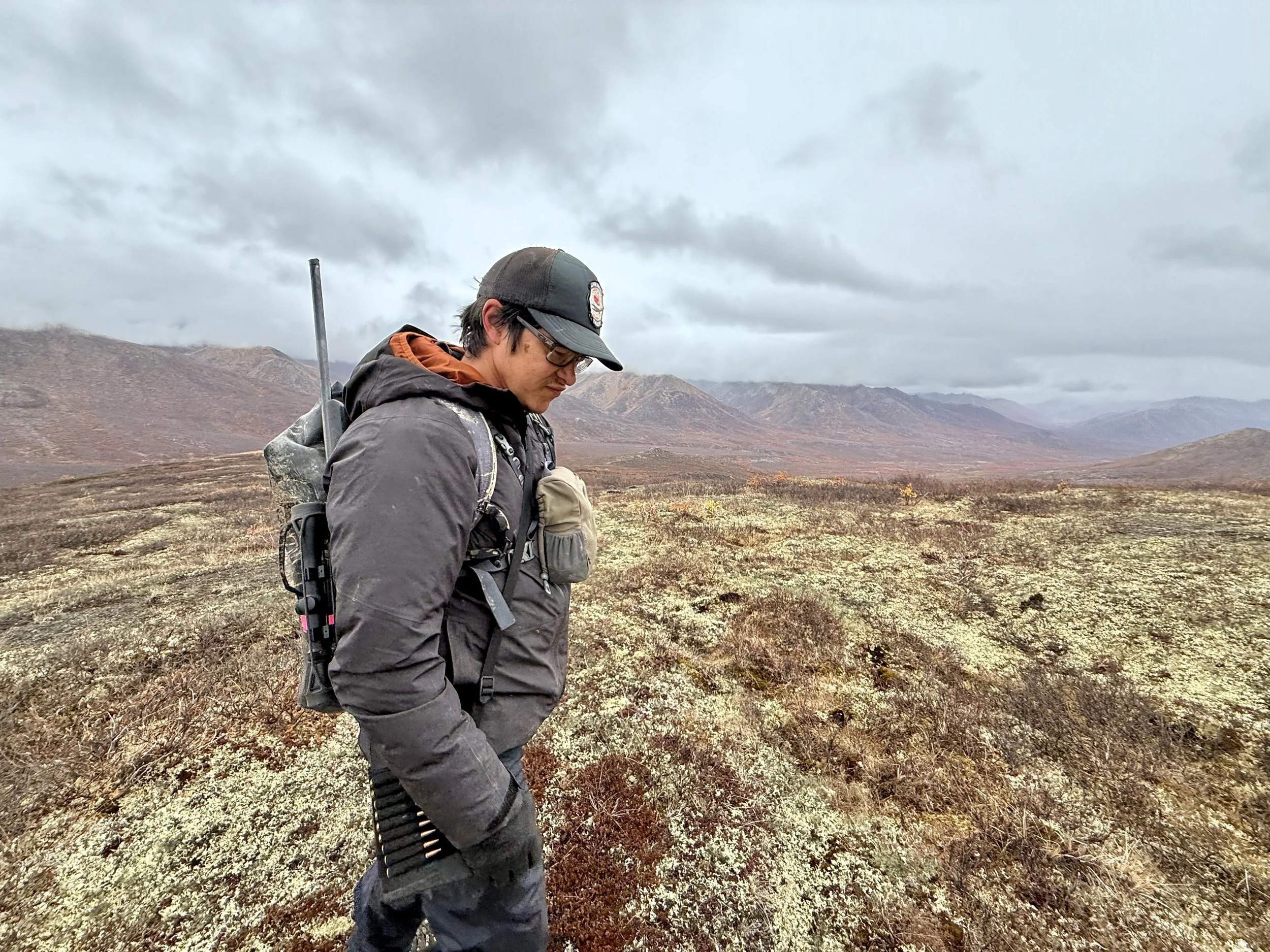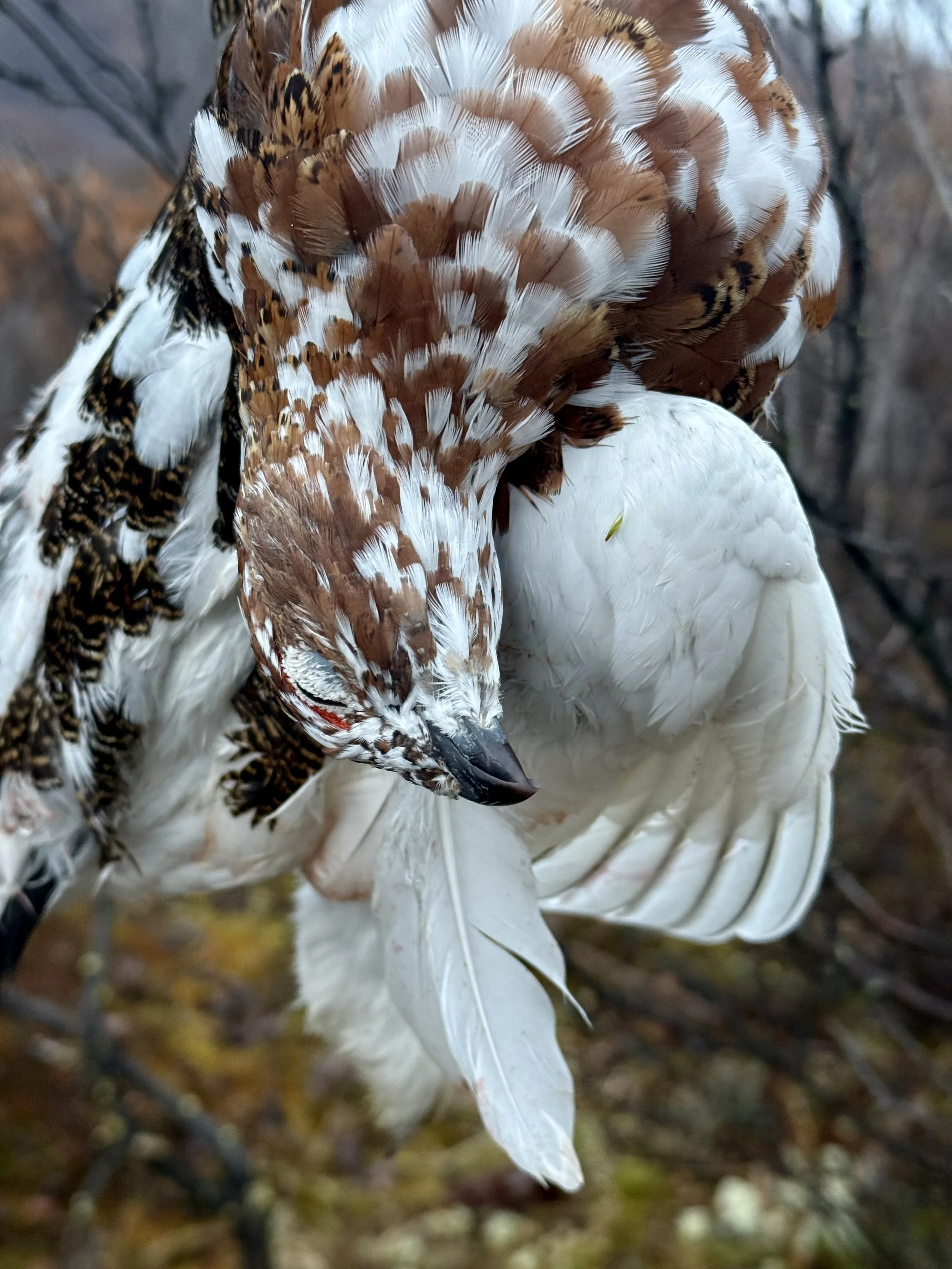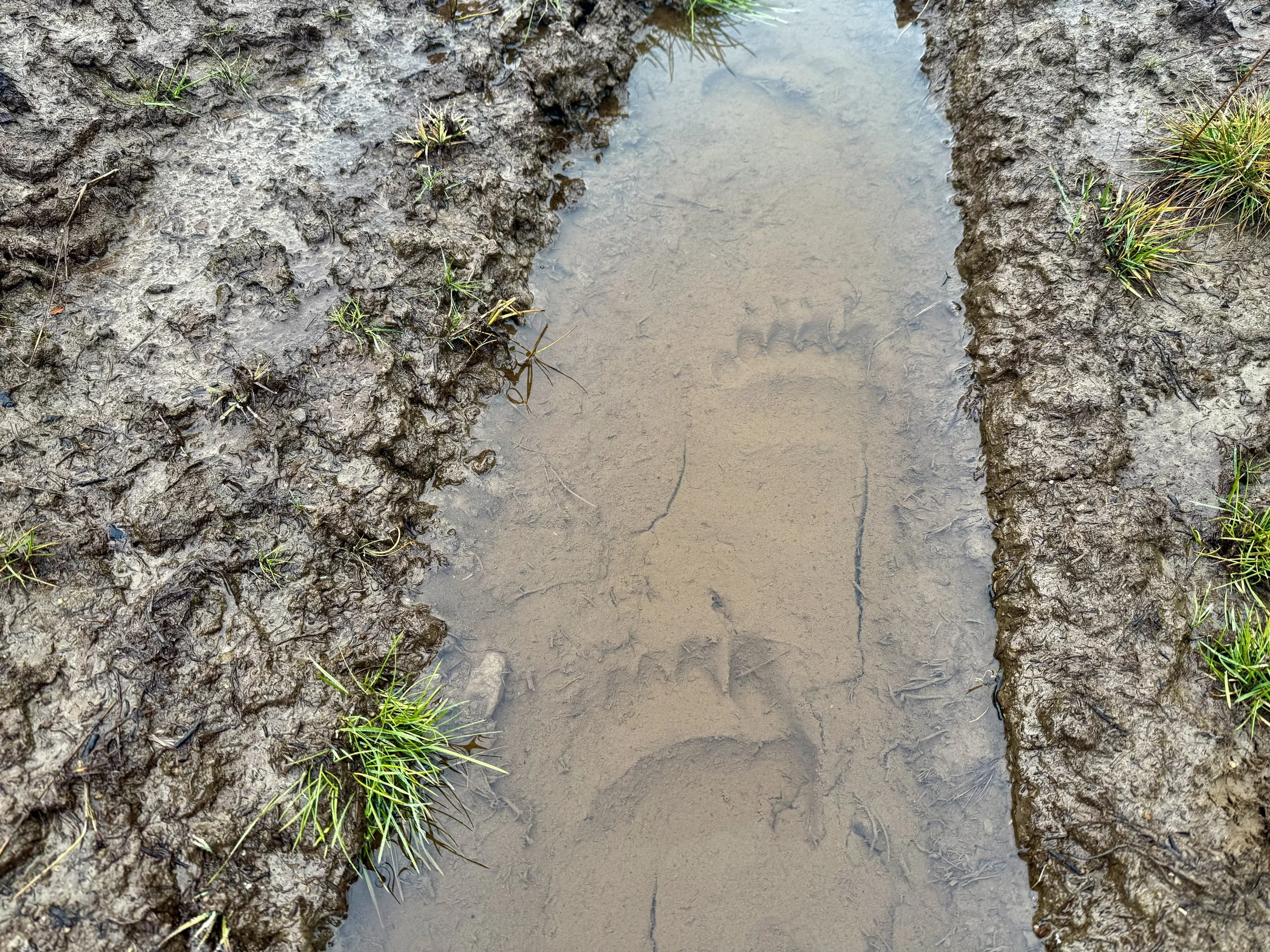Dispatches from the Dempster
A Long-form Essay on Anxiety, Survival, Looking for Caribou—and Finding Ourselves Down Grizzly Trails
As we drive north, my i-phone switches into S.O.S. mode—as if it needs saving. M, my partner, is at the wheel towing a trailer with a quad and everything we need to be self-sufficient for five days up the Dempster Highway, a 736-kilometre gravel road that connects Dawson City, Yukon to Inuvik, NWT. The Dempster is the only public highway in Canada that crosses the Arctic Circle, though the descriptor of ‘highway’ is something of a misnomer. The road is so skinny that M veers to the shoulder when the odd semi-truck comes barreling by, long hauling petroleum parts so large that they look as though they are destined for the moon.
The construction of Dempster Highway was the brainchild of Canada’s Prime Minister, John Defienbaker in the late 1950s. Defienbaker’s “Roads to Resources” program intended to penetrate northern regions rich with oil, silver, and gold. Never mind consultation with First Nations communities, the roads ploughed through plains and valley basins in the Yukon and NWT that once homed barren-land caribou in the hundreds of thousands.
The Dempster wouldn’t be completed until 1978, although the word ‘completed’ feels false. As we pass a small highway crew building back up a near vertical embankment, it’s a reminder of the Dempster’s fragility, a road prone to mud slides, permafrost slumps, and treacherous ice.
There is no cell coverage here. If you break down, or careen off the road, no one is coming to save you.
I prop my feet up on the dash and lose myself in the blur of autumn colours—hues of ochre, mustard yellow, and burgundy rust—sliding by. It’s a meditative act that’s followed me from childhood, the result of living in a remote community that required long-distance travel to get, well, anywhere.
I feel the beauty of the land intensely. I feel it mixing with the pain I’ve been feeling for the state of the world, for 270 Palestinian journalists dead, for genocide, a designation that took scholars two years and over 60,000 people killed to agree upon. I recently joined 243 Canadian authors in signing my name to an open letter protesting the targeted killing of 244 journalists living in the occupied state of Palestine. My name appears next to Khaled Abu Seif, a journalist who was targeted by the Israeli Defence Force, alongside his wife, Nour Qandil—also a journalist—and their young daughter in Deir el-Balah in May. My throat constricts like a dam.
M and I are traveling north in pursuit of woodland caribou, or maybe a moose, to fill up our freezer for the winter. I needed this trip, I tell myself. My body and mind are weary. Burnt out. Only two nights earlier, I woke at 3 AM to another panic attack.
I experienced my first panic attack during the early days of the pandemic, waking in pool of perspiration, seized by an unyielding dread that my lungs were infected with the COVID-19 virus. It can be challenging to explain to those who don’t struggle with anxiety, what an attack feels like; the way your arms and legs deaden like 2x4s, your heartbeat bolts on you like a feral horse, and your mind locks onto thoughts, however extreme, or untrue. The panic attacks became more frequent and intense after my brother died. Three years later, though I’ve built a beautiful home and community, panic still ignites—my mind fixating on a worse-case scenario that usually involves me losing someone, something, and dying alone. While the attacks only last ten minutes, or so, afterwards I feel as though I’ve been hit by a semi-truck.
My partner has a mechanical, fix-it mindset. He offers me practical solutions: stop drinking coffee, focus on your breath. Meditate. “Everyone is at least a little depressed, aren’t they?” he says gently. My partner approaches life with the singularity of purpose. He narrows in on what’s in front of him, although it’s not as if he’s immune to the wider existential threats—fascist politics, genocide, climate crisis. We speak often about these realities. We both feel it.
I can’t stop thinking about the writer and author Arundhati Roy, who recently spoke at the University of Toronto, reminding the audience that had gathered to listen to her talk about her new book, “This book was written during the period of the live-streamed genocide in Gaza and the sorrow of that infuses this as it has infused everything that we do…”
On the same morning I experienced the panic attack, I woke to a subject header of an email from the Science Media Centre of Canada that summed up the latest published climate research:
More smoke kills | Hot salmon | Roaming mastodons | Body plastic | Canuck emitters.
Western democracy isn’t just crumbling, it’s calving like a glacier. The planet is aflame. Species loss looms while the U.S. administration dismantles scientific research institutions. They’ve all but banned the words climate change. Other words on Trump’s black list: female.
the sorrow of that
infuses this
Lately, I’ve struggled to understand how we can do all the things we do while bearing witness. I don’t know what to tell my niece and nephew about the future they’re going to inherit. I don’t know what the answer is other than that anxiety feels like a perfectly natural response right now.
*****
My lookout colleague Marina always used to say it would take one to two weeks at the start of every tower season to shed your city energy and for the forest to accept you back. I think of Marina’s words as I nervously try to keep pace with M across a 45-degree angle mountain slope carpeted in loose black shale that characterizes the Ogilvie mountain range.
An hour ago, we pulled off the Dempster around the 150 kilometre mark, further north than where we had intended to stop at the Hart River road, an old gold mining road built in the 1960s. But the pull-out had been crammed with five large trucks and trailers. M didn’t want to hunt with so many people in the area, so we drove further north, passing through the Blackstone Valley, where barren-land caribou herds once migrated in the hundreds of thousands and Tr’ondëk Hwëch’in hunters followed. The Ogilvie mountains rose up behind the golden bowl of the valley, grey sentinels who’d witnessed it all.
Here, we aren’t allowed to unload, or operate the quad, however. Aside from the Hart River road, there’s no ATV-access permitted along the Dempster Highway in order to protect the sensitive peatland ecosystem. So we set out on foot, packs on our backs, rifles slung around our shoulders. Five minutes into the hike, I’m frustrated with this precarious route along the side of the steep grey mountain, however. It doesn’t even feel like caribou habitat, to me.
“Maybe sheep,” I huff.
With every step, small shards of grey-black rock cascade down the slope. I’m going to fall, my mind plays on repeat. M takes my rifle so I can use both hands to balance myself against the slope. Down below, we cross a meandering stream and water sloshes over the lip of my water-proof boots.
“Shit!” I know I am being too loud and can I sense that M is annoyed. A willow whips my pant-legs. My soggy feet sink into the sphagnum moss. It’s like balancing atop a lumpy mattress and I’m a toddler learning how to walk all over again. The strap of my rifle bites into my shoulder. We’re trying to reach a grassy, tussock covered ridge, but there’s a moat of black spruce and swamp to cross. Maybe this is woodland caribou habitat, I realize. A protective refuge for woodland caribou to hide and outmaneuver predators.
M locates a trail padded down by unmistakable tracks: grizzly bear. You can draw a straight line across the toe pads, differentiating it from the track of a black bear, which rises into a gentle arc. The grizzly’s four-inch long claws dig into the wet earth.
My inner demons go quiet.
I am suddenly noticing everything about this trail. How the bears chose the easiest, driest route that winds through patches of cranberries and soapberries. Purple scat piles are littered along the trail. One dried heap contains the hairs of what looks like moose. At a junction there’s a skinny spruce tree whose lower branches have been sheared off. Golden matted hairs cling to the bark as though the tree has grown fur. I haven’t seen a rub tree like this since I left my fire tower in northern Alberta. I pull off a clump of hairs and hold them to my nose. It’s an earthy, pungent musk I’d recognize anywhere. Like onions frying in oil: you know it when you smell it.
“Bear?” M asks.
“Definitely.”
We don’t make it to the ridge where we might have a chance of seeing caribou. The tussocks are deceivingly difficult to traverse. From afar, it appears like a grassy hillside, but up close, the tussocks are large as anthills and covered in cured grasses. You can’t see where the mounds begin, or end. I fear with one misstep I could tumble off a tussock and break an ankle. As the light dims, the ridge line looms in the distance. We aren’t going to see caribou tonight. We follow the same well-worn grizzly trail back to the truck to make camp for the night.
M boils water for pasta, while I roast smokies over a fire. The sky blackens above us. As the temperature drops, the stars pulse as though shivering in the cold. We crawl into the tent, the zippers on our sleeping bags facing one another. M extends an arm into my sleeping bag to hold me. His touch comforts and I feel my frustrations surrendering to exhaustion. I want to cry. Anxiety is exhausting. I don’t want to feel so anxious all of the time.
We say goodnight. Then I immediately hear it: a dried leaf, crunching underfoot. M hears it, too. I can sense he’s holding his breath, waiting for another auditory cue. But seconds pass and we hear nothing else. Minutes later, he’s asleep. Every exhale long and measured.
I stay awake thinking of the well-traveled grizzly trail, how it wove with the land, not against it. How the bear is far better hunter than I am.
*****
In the morning, frost covers the surface of everything. The cold bites our exposed hands. We pack and go, driving south in silence, my wet boots cooking on the heaters of the truck’s dash.
We stop in the Blackstone Valley at a small pond and watch a trumpeter swan lift off and give chase to a goose. The swan, three times the size of the goose, flaps furiously behind the goose, picking up speed. The goose’s wings whir as frantically as one of those hand-held battery powered fans. They fly a lap around the pond, going nowhere, wasting precious energy—for what? We both laugh at the absurdity of it.
“Grumpy swan,” I muse, as both birds skim the surface of water and land—albeit the goose on the opposite side of the pond.
We drive back towards the Tombstone mountain range. There’s less black shale here, more dwarf birch and willow. The mountains are carpeted in pale-green reindeer lichen so thick you can see it from the highway. This is home-range to the Hart River woodland caribou herd, one of the healthiest and stable woodland caribou herds in the Yukon at over 2500 animals.
We’re relieved to see only two remaining vehicles in the Hart River road pull-out. M unloads the quad and trailer, I pull on my rain pants and muck boots. We pack and cover the trailer with a tarp, hop on the quad, and cross the Dempster highway. The trail cuts through a mountain pass, edged with thick willow and dwarf birch. The mountains rise up on both sides.
“You’ve gotta be our eyes,” M says, as he navigates the quad through a muddy section of trail.
My eyes instinctively glass the mountainsides. Looking for wildlife isn’t so different than looking for wildfire smoke. You look for irregularities in the pattern of the landscape: colour, shape, movement. My eye snags on a dark form on the side of a steep ridge. We stop and I peer through the binoculars. It’s some kind of bird of prey—maybe a golden eagle—perched on a rock.
“Good eye,” M says.
Looking for wildlife requires that you know something about behaviour and habitat, but in a valley as vast as this one, it’s also largely about luck and timing. Now you see it now you don’t. The valley is virtually empty of trees—only a handful of small, lonely spruce are scattered on the slopes—instead it’s carpeted in spongey sphagnum moss, lichens, berries and “buckbrush”, or willows. Beneath the surface lies thick permafrost, a subsurface layer of soil that remains frozen throughout the year. This is a valley of water—frozen water.
We hear a high-pitched sound coming towards us, a faint hum of an engine, then a voice—a woman’s voice. The side-by-side appears ahead on the trail and M pulls over to the side to make room for them to pass. A blonde guy in his early 30s is at the wheel. A blonde woman is buckled into the seat beside him. They are both wearing matching camouflage hunting jackets and pants. I notice that the woman is wearing fake eyelashes and I can’t help but wonder if she’s one of those influencers on social media: selling a blend of adventure, sex appeal, and trophy lust. She looks cold and exhausted.
“See anything?” M asks, both vehicle engines idling. By “anything” he means caribou.
“Absolutely nothing,” the guy says. “Temperature dropped and they’ve gone up into the mountains. Lots of bears, though,” he says, grinning boyishly.
He launches into a story about shooting a grizzly feeding on a caribou carcass from more than five-hundred yards away. Later, I’ll realize he wanted to impress us with this distance.
“I missed and he took off, but that’s how we got the caribou head,” he says. I glance back at his trailer and see a pair of caribou antlers roped down on the top. “I was hoping we’d catch up with the bear this morning, but we couldn’t find ‘em.”
An hour later, as we’re setting up camp beneath a rocky highpoint with a 360-degree viewpoint, M and I debrief the encounter with the couple in matching camouflage.
“I wish I would’ve asked him what “lots of bears” meant,” I say. “He made it sound as though the valley was crawling with them, but I bet you it was the same bear.”
“I was more concerned that he took a shot at the bear from five-hundred yards away,” M says. “There’s a high chance you’re going to wound an animal at that distance.”
It dawns on me what M is really saying. He finishes the thought for me.
“I don’t want to run into a wounded grizzly out here.”
M has a hunting tag for a grizzly, but only as a kind of insurance policy, in the very rare case he has to shoot one out of self-defence. Like me, he doesn’t really get the appeal of hunting a grizzly. For what—a rug? A stuffed, taxidermic head with the jaw wired open into a mock roar? It’s legal to hunt a grizzly in the Yukon, although you can only kill one grizzly every three years. You aren’t legally required to take the meat—just the head, hide, and paws.
I think of the grizzly and the effort and skill it required to stalk and kill a caribou, or even to claim the carcass from a pack of wolves—that bear must’ve known a thing or two about survival. Feeding on a caribou in late September would almost guarantee its chances of enduring the winter in torpor.
That the hunter was willing to pull the trigger at such a long distance—and risk injuring the bear—spoke volumes about his ethics.
“It’s dumb when hunting couples match like that,” I grumble. “Let’s never become that couple.”
M points down to my navy blue Patagonia rain-paints and then to his own. I forgot that we randomly owned the same pair. We’re also wearing black anoraks, albeit different brands.
“Oh shit, we already are that couple.”
We both crack up and the sound of our laughter eases my anxiety. It feels good not to take ourselves too seriously.
*****
I follow M up the side of the mountain. He points out the sign of caribou everywhere: a well-trodden trail that weaves through the shoulder-high willows. Their tracks are distinct from moose, which always remind me of two exclamation marks: !! Caribou tracks are smaller and curved like two crescent moons facing one another. M points out a haggard spruce tree whose middle branches have been broken off.
“Caribou have been beating up on this tree,” he says, explaining how they rub off the itchy, drying velvet from their antlers. Like bears, they leave their scent behind as a way of communicating to others who they are—and their relationship status.
As we zigzag up the steep slope covered in a carpet of lichen, we bend to pluck blood red cranberries and stuff them in our mouths. Every now and then, I stop and look over my shoulder, dazed by the view of the valley below.
M points to the face of a mountain on the other side of the valley and recounts a story of sneaking up to a small caribou herd, nearly a decade earlier.
“The bull dropped and the rest of the herd took off through the valley so fast,” he remembers. “Caribou can really move when they want to.”
Large swaths of fog drift through the valley. Heavy blue clouds drape low in the sky. We know that we’re about to get completely socked in, but we keep climbing, anyway. When we crest the top, my lungs heave with exertion. The ghostly valley below is so staggeringly gorgeous that my chest aches with awe.
“Most people on the planet wouldn’t be able to comprehend this much land,” I muse to M and he nods.
What I mean to say is that I feel sharply aware of our privilege to play witness to such beauty, to tread safely on the land without the fear of being targeted, displaced, or erased. I think of a video I watched last week of olive groves in Palestine’s West Bank being bulldozed by the Israeli Defence Forces.
We lay back against the buoyant lichen and rest for awhile in silence. The fog materializes on our jackets as jewelled beads of water. A sudden rush of feathers startles the air, as a golden eagle swoops up the slope. We spot two others, circling above. A family. I wonder what they’re hunting for.
*****
Rain falls overnight and water seeps in through the corners of the tent, soaking my rifle bag. We wake to the sound of a ptarmigan flying overhead, seemingly mocking us.
“Fuckyoufuckyoufuckyou,” M mimics the sound of the ptarmigan from his sleeping bag.
I chuckle and peek through the window and see nothing, only fog. If caribou are nearby, we wouldn’t have a clue. M has told me how they can silently materialize on the landscape. Some mornings, he’s woken to caribou grazing on lichen right outside his tent. I zip open the tent, however, and it’s as though the world has been erased.
“No caribou,” I say.
We boil water for oatmeal and cranberries and instant coffee. The foggy sky breaks, revealing shards of magnificent colour. The water-soaked mountains gleam like a burnished penny.
Later, when the sun has burnt off most of the fog, M loads up the quad and we ride further into the valley, crossing thigh-high streams, and getting stuck and then unstuck in the boggy lowlands. We hike up a mountainside, hoping to catch a glimpse of a caribou herd, or a lone moose, but the hillsides seem empty of ungulates, a feeling that I know is untrue. They are there, but we just can’t see them. My eyes ache from glassing afar. I lay down on my stomach and photograph the fattest cranberries I’ve ever laid eyes on. We gorge like grizzly bears.
On the ride back to our campsite, I notice something white scuttling in the willows. Ptarmigan. We have an unfair advantage. The waning seasonal light has already trigged their plumage to turn from brown to white. They stand out like flags against the pallet of orange and brown hues. There’s at least five of them. They freeze in the willows.
Quietly, M retrieves the .22 rifle and hands it to me.
I lean against the quad and steady the rifle, trying to line up the shot, aiming for the bird’s head. I am acutely aware of my breath. A few weeks earlier, we went to the gun range in Whitehorse and I was reminded of the necessity of controlling the breath. At first, I felt that familiar panic rising in my chest. My palms and fingers were clammy with sweat. “Don’t focus too hard on the target,” M had told me. “Look away, readjust your gaze, and then look back and take the shot.”
His advice worked. I quieted my breath and decisively took the shot: a near bull’s eye.
I pull the trigger and there’s a sudden explosion of feathers. The ptarmigan—triple the number we thought were hiding in the bush—take off in collective flight. I somehow completely missed the bird.
We marvel at the flock of ptarmigan against the dramatic backdrop of the mountains. They are not a graceful bird, but they are beautiful in large numbers. They fly a curved trajectory and land in the willows on the ridge above, not far from our campsite. I spy a northern harrier, a bird of prey, circling above their landing spot. The harrier is hunting, too.
We go looking for the ptarmigan on foot, following their distinct taunts: fuckyoufuckyoufuckyou. We weave our bodies through the head-high willows, a labyrinth of branches that threaten to snare our limbs. M spots a ptarmigan frozen on the spot. He sneaks closer to take the shot, fires, and the bird lifts off—completely unscathed. The .22 is not sighted in properly.
“We’ve got to aim low,” M says.
We creep on through the thicket. There’s another bird close by. M takes the shot, aiming at the feet, and, this time, he’s successful. The bird staggers forward and flutters its white and brown speckled wings frantically, a reflex action caused by the triggered nervous system.
“It’s a male,” says M, pointing to the bird’s distinct red eyebrow.
He plucks the ptarmigan on the spot and the bird’s bright white feathers drift to the ground like snow.
*****
I sleep deeply on our last night up the Dempster. It’s the deepest I’ve slept in what feels like months. The tension in my body has relaxed, at last. I know this much about myself: I feel the most calm and connected version of myself while out on the land.
I am not afraid of bears in the same way I’m afraid of fascist politics and the normalcy of violence.
I think of something a journalist once asked me, about living alone at the fire tower. She asked if I felt a sense of climate anxiety, being on the land. But the truth is that I never felt as anxious at the tower as I did when I was back in society, disconnected from the land.
When you’re on the land, you’re focused on the present moment: responding to the weather and wildlife, eating enough food, building a shelter. When you’re on the land, you regain control of your breath. You feel clarity of purpose. You’re drawn in closer to your loved ones.
“I don’t want to go,” I say to M as we punch our down sleeping bags back into their compression sacks and roll up our air mattresses.
I boil water for coffee. The tent comes down like a deflated balloon. The temperature dropped overnight and my gloves are damp from the moisture that’s accumulated on the surface of everything. I feel a distinct chill entering my bones. I think of the female hunter with fake eyelashes and feel a pang of guilt for judging her. It’s damned cold out here.
“Maybe we should just go to the Bahamas next time,” M says cheekily.
We drive back through dense fog towards the Dempster highway. The cold cuts through my now wet gloves. I shiver and wrap my arms tighter around M. I keep my eyes peeled for any dark figures on the mountainside: caribou, moose, grizzly bear.
M slows the quad and points out fresh grizzly tracks along the trail.
“Looks like a small grizzly,” he says, and I can’t help but wonder if it’s the one that survived.
*****
On the drive back to Whitehorse, around Stewart Crossing, my cell phone pings with 33 unread emails. The news flashes on my phone: Prime Minister Mark Carney has officially recognized the state of Palestine. The U.K. and Australia have done the same. A day later, France will follow.
It’s hard to know what to feel, but I know this doesn’t feel like enough. How many people have to be killed in order for so-called democratic states to care, or intervene? What was that the United Nations once touted in the 1990s: Never again? These words today ring as hollow as they rang hollow following genocides in Darfur, Rwanda, and Bosnia.
We cannot say, we did not know what happened (and is happening) in Gaza. We are watching it on our phones.
My phone buzzes again, but I place it face down on the seat. The north Klondike highway unwinds behind us. I think of the bear, the caribou, and the fragile line between sorrow and survival.
Somewhere far away, another signal blinks—S.O.S.—a call for help that we can’t afford to ignore.
*****
Post-script: On October 8, 2025, The Guardian published the names of 18,457 children under the ages of 18-years-old who have been killed by the Israel Defence Force in Gaza since October 2023.
Excerpt from the article:
“Together they account for nearly one-third of all the war dead whose bodies have been collected and identified before burial.
The list of named victims maintained by health authorities in Gaza is recognised as authoritative by the international community, the UN and Israel’s military, although Israeli politicians frequently try to dismiss it.
But the strict rules that ensure its credibility also mean it cannot capture the full scale of tragedy inflicted on Gaza’s children and their families.
Missing from the toll are the thousands of victims still buried under the rubble of destroyed buildings as well as the war’s many indirect victims. Israel’s blockade has created deadly shortages of food, medicine, clean water and fuel.” —The Guardian, October 8, 2025
